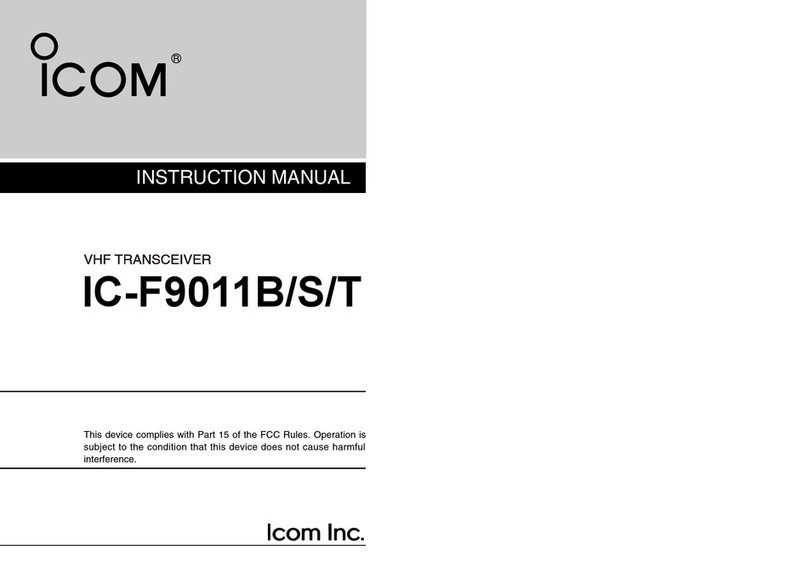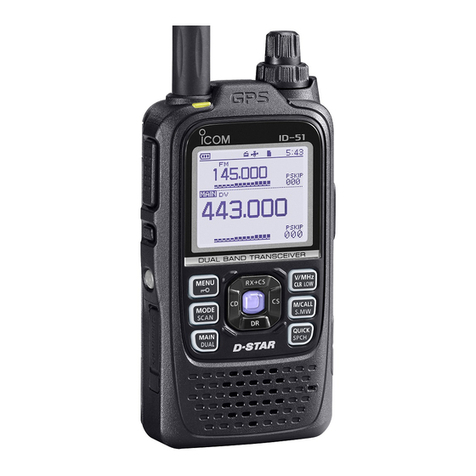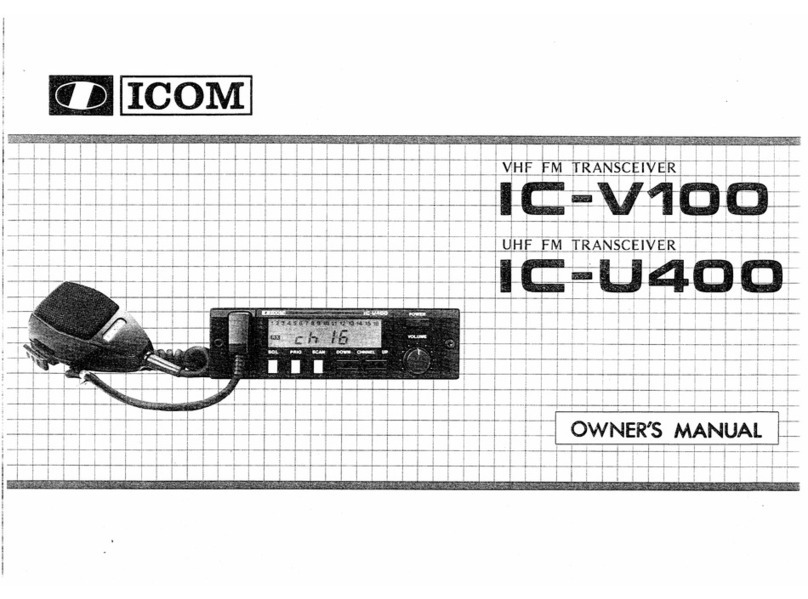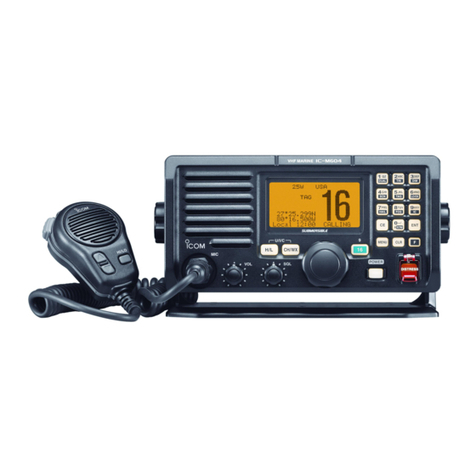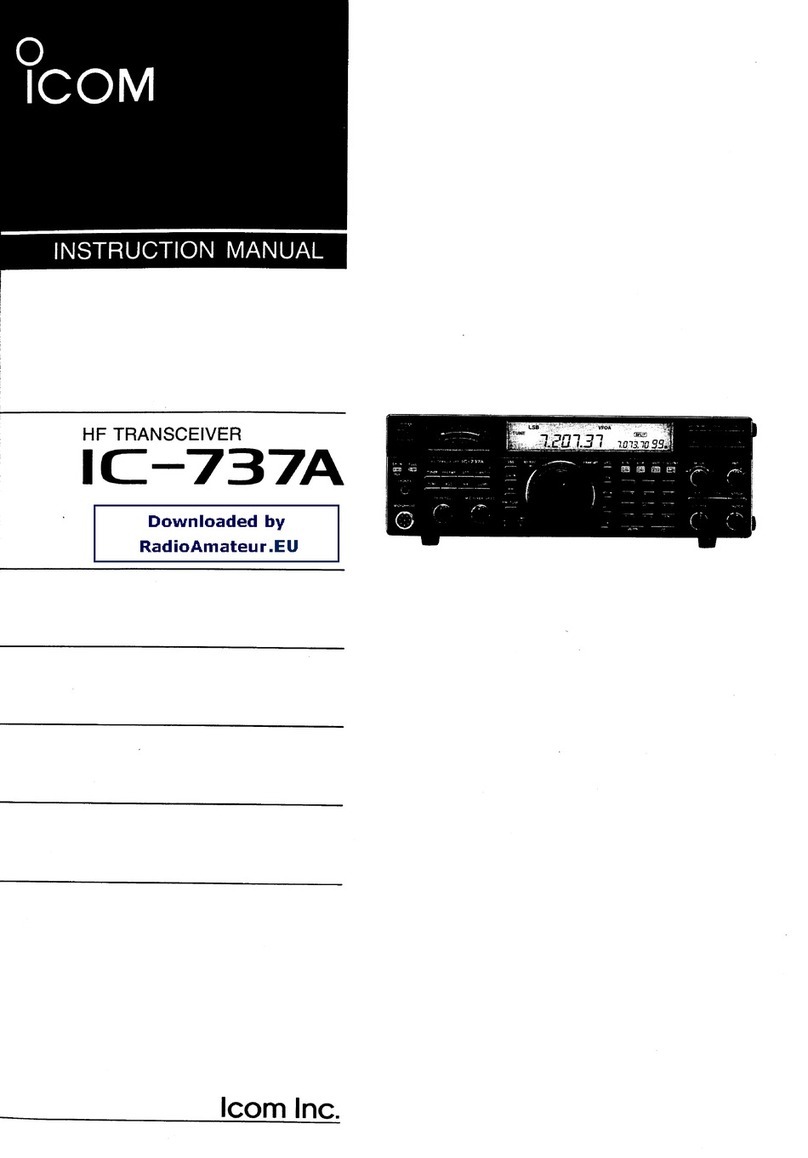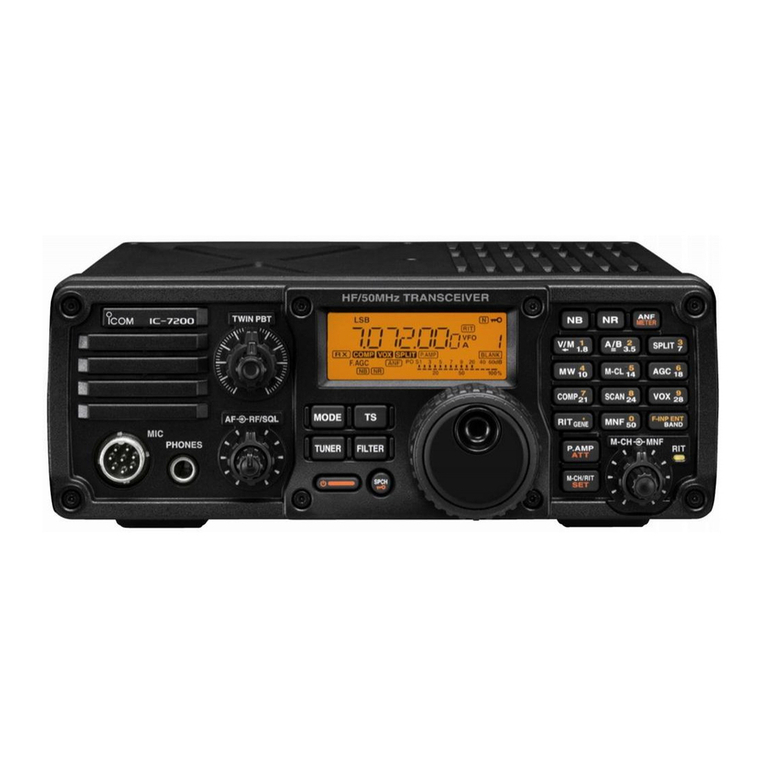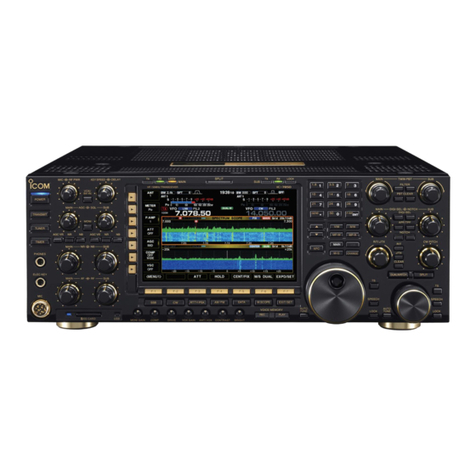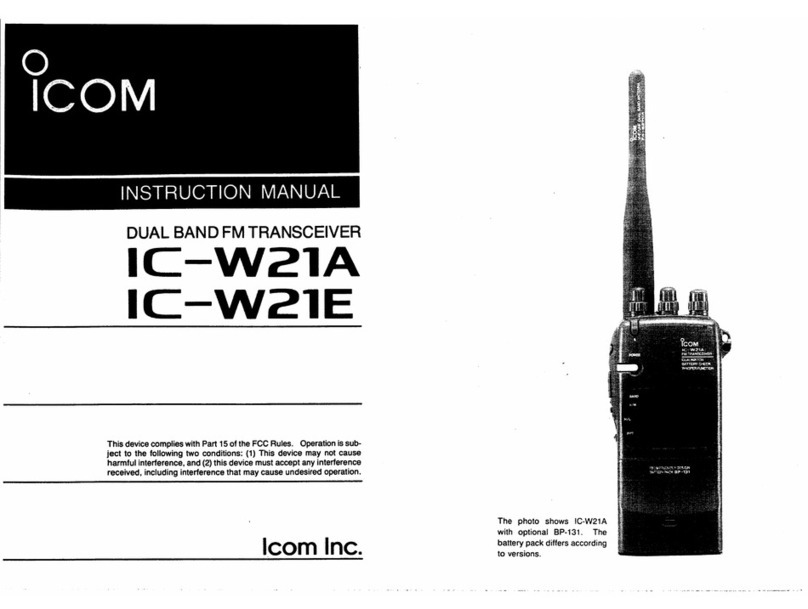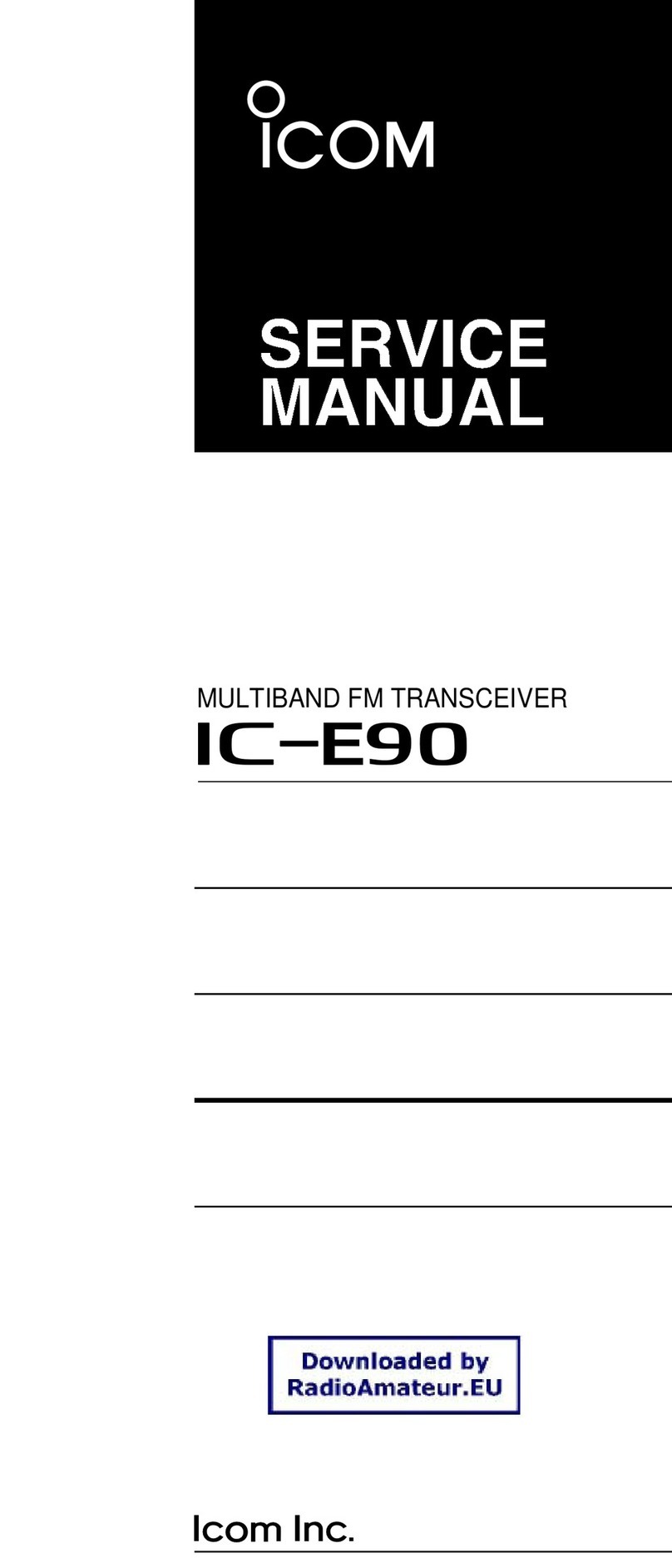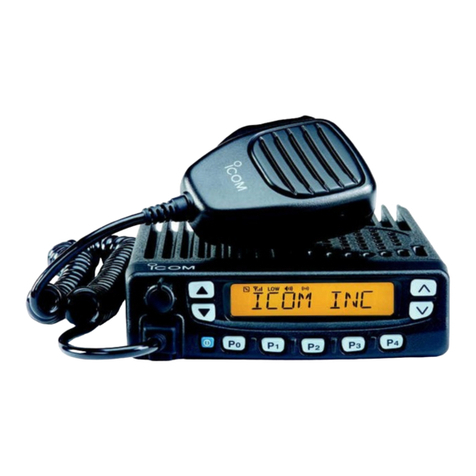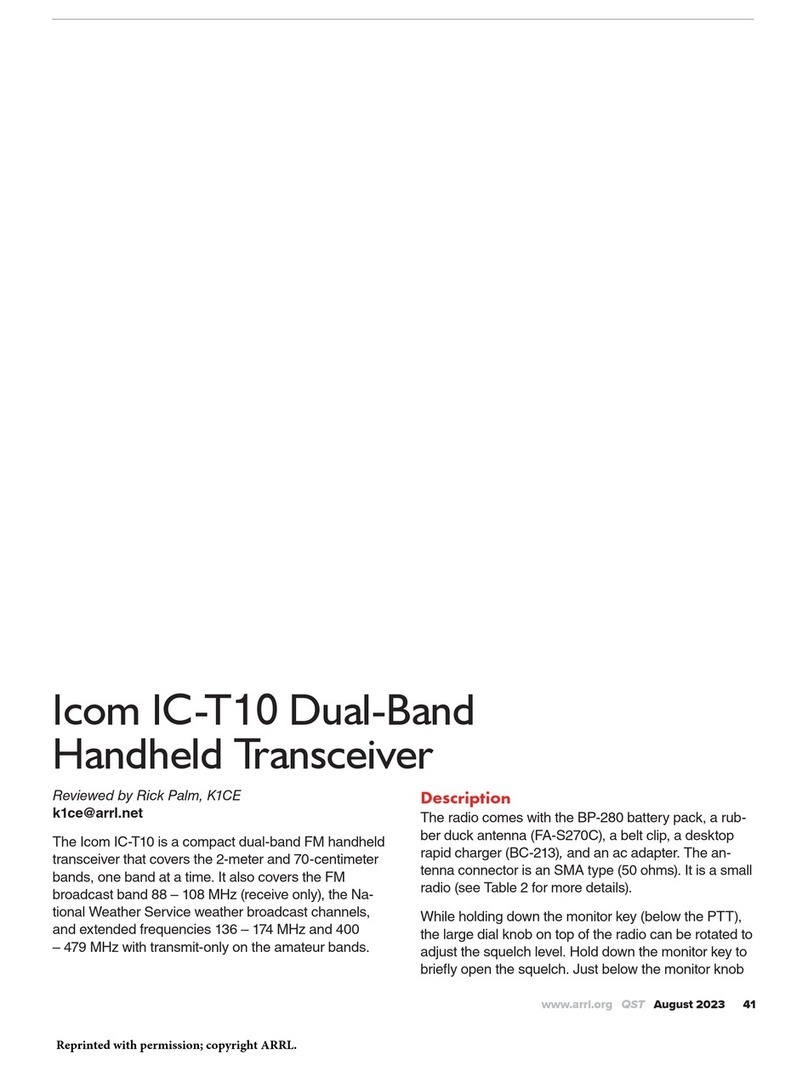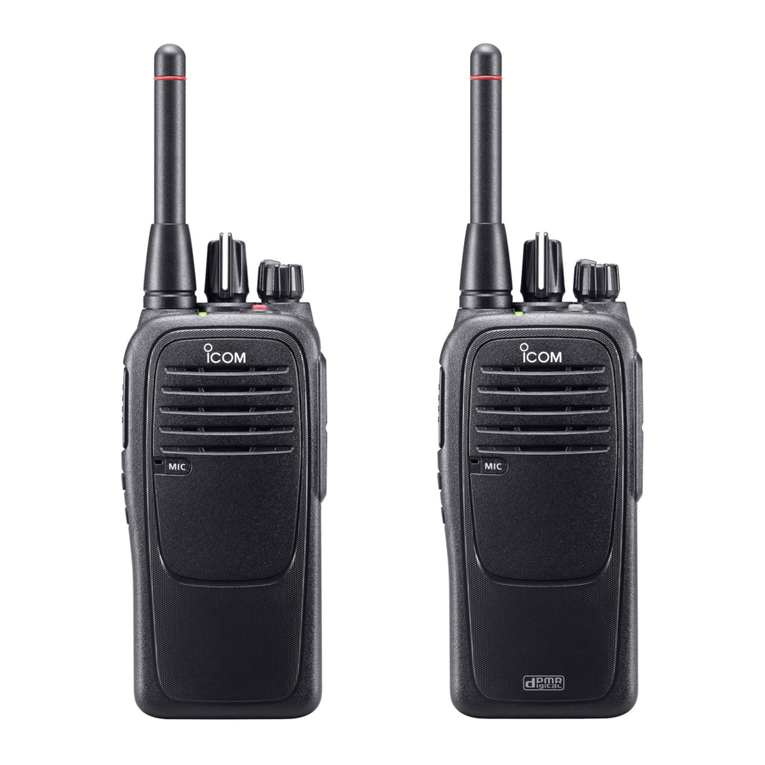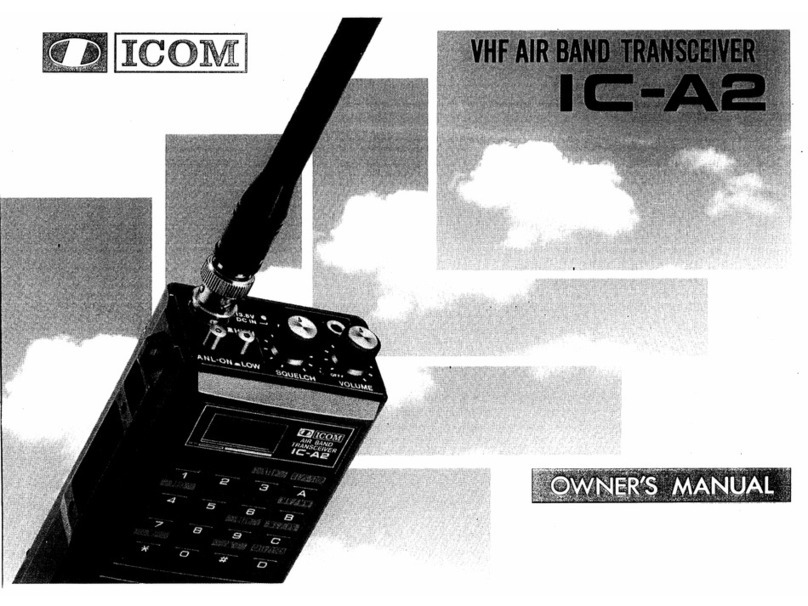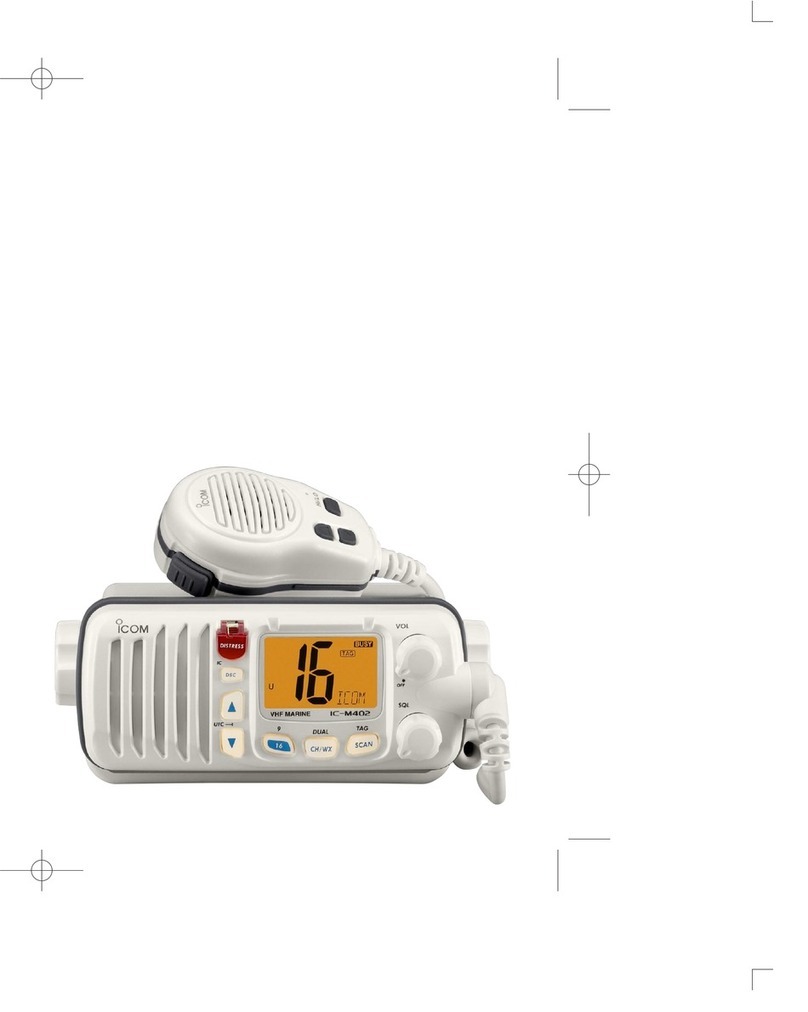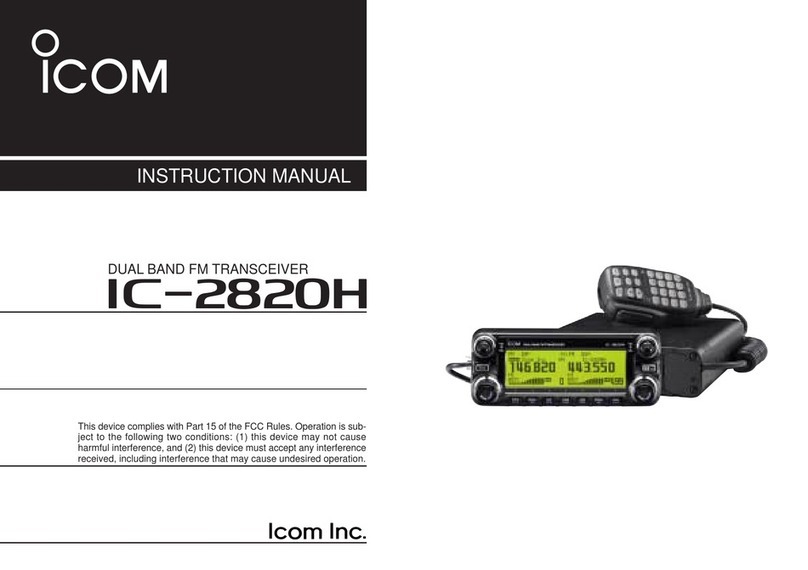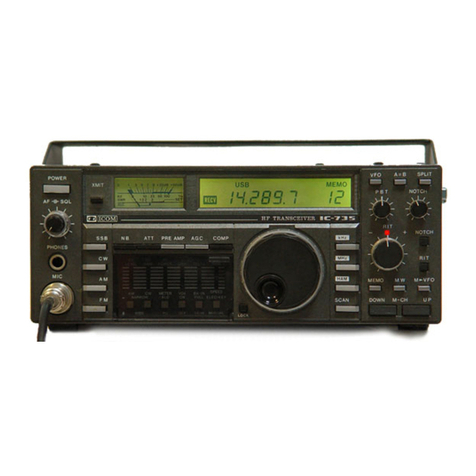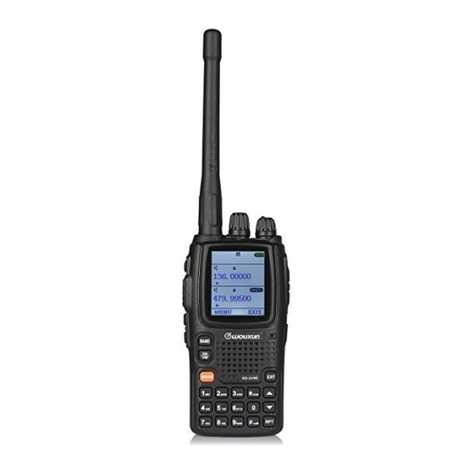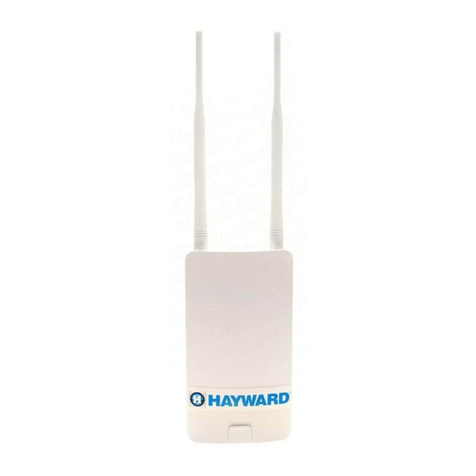Icom IC-M2A User manual

INSTRUCTION MANUAL
iM2A
VHF MARINE TRANSCEIVER
This device complies with Part 15 of the
FCC Rules. Operation is subject to the
condition that this device does not cause
harmful interference.

ii
FOREWORD
Thank you for purchasing this Icom product. The IC-M2A VHF
MARINE TRANSCEIVER is designed and built with Icom’s su-
perior technology and craftsmanship. With proper care this
product should provide you with years of trouble-free operation.
IMPORTANT
READ ALL INSTRUCTIONS carefully and com-
pletely before using the transceiver.
SAVE THIS INSTRUCTION MANUAL—This in-
struction manual contains important operating instructions for
the IC-M2A.
EXPLICIT DEFINITIONS
FEATURES
☞Water-resistant construction
Built tough to withstand the punishing marine environ-
ment, the IC-M2Ameets JIS water-resistant specification
grade 7.
☞Dual watch and tri-watch functions
Convenient functions which allow you to monitor the dis-
tress channel (ch 16) while receiving a channel of your
choice—dual watch; or monitor the distress channel and
another channel while receiving a channel of your
choice—tri-watch.
☞Large, easy-to-read LCD
With dimensions of 24(H) ×35(W) mm, the IC-M2A’s
function display is easy to read and shows operating con-
ditions at a glance. Backlighting and contrast can be ad-
justed to suit your preferences.
☞Simple operation
Ergonomic design with a minimum number of switches
and controls provides simple intuitive operation.
WORD DEFINITION
RWARNING Personal injury, fire hazard or electric shock
may occur.
CAUTION Equipment damage may occur.
NOTE If disregarded, inconvenience only. No risk
of personal injury, fire or electric shock.
After exposure to saltwater, clean the transceiver thor-
oughly with fresh water to avoid corrosion.

iii
CAUTIONS
RWARNING! NEVER connect the transceiver to an
AC outlet. This may pose a fire hazard or result in an electric
shock.
RWARNING! NEVER hold the transceiver so that the
antenna is very close to, or touching exposed parts of the
body, especially the face or eyes, while transmitting. The
transceiver will perform best if the microphone is 5 to 10 cm
away from the lips and the transceiver is vertical.
NEVER connect the transceiver to a power source other
than the BP-223 or BP-224. Such a connection will ruin the
transceiver.
AVOID using or placing the transceiver in direct sunlight or
in areas with temperatures below –20°C (–4°F) or above
+60°C (+140°F).
KEEP the transceiver out of the reach of children.
KEEP the transceiver at least 1 meter away from your ves-
sel’s magnetic navigation compass.
BE CAREFUL! The transceiver rear panel will become
hot when operating continuously for long periods.
BE CAREFUL! The IC-M2A employs waterproof con-
struction, which corresponds to JIS waterproof specification,
grade 7 (1 m/ 30 min.). However, once the transceiver has
been droped, waterproofing cannot be guaranteed due to the
fact that the transceiver may be cracked, or the waterproof
seal damaged, etc.
MAKE SURE the flexible antenna and battery pack are
securely attached to the transceiver, and that the antenna and
battery pack are dry before attachment. Exposing the inside
of the transceiver to water will result in serious damage to the
transceiver.
KEEP the transceiver at least 1 m (3.3 ft) away from the
ship’s navigation compass.
KEEP the transceiver out of the reach of children.
For U.S.A. only
CAUTION: Charges or modifications to this device, not
expressly approved by Icom Inc., could void your authority to
operate this device under FCC regulations.

iv
SAFTY TRAINING INFORMATION
Your Icom radio generates RF electromagnetic
energy during transmit mode. This radio is de-
signed for and classified as “Occupational Use
Only”, meaning it must be used only during the
course of employment by individuals aware of
the hazards, and the ways to minimize such
hazards. This radio is NOT intended for use by the “General Popula-
tion” in an uncontrolled environment.
This radio has been tested and complies with the FCC RF exposure
limits for “Occupational Use Only”. In addition, your Icom radio com-
plies with the following Standards and Guidelines with regard to RF
energy and electromagnetic energy levels and evalution of such lev-
els for exposure to humans:
• FCC OET Bulletin 65 Edition 97-01 Supplement C, Evaluating
Compliance with FCC Guidelines for Human Exposure to Radio
Frequency Electromagnetic Fields.
• American National Standards Institute (C95.1-1992), IEEE Stan-
dard for Safety Levels with Respect to Human Exposure to Radio
Frequency Electromagnetic Fields, 3 kHz to 300 GHz.
• American National Standards Institute (C95.3-1992), IEEE Rec-
ommended Practice for the Measurement of Potentially Haz-
ardous Electromagnetic Fields– RF and Microwave.
WARNING
To ensure that your expose to RF electro-
magnetic energy is within the FCC allowable
limits for occupational use, always adhere
to the foliowing guidelines:
• DO NOT operate the radio without a proper antenna attached,
as this may damaged the radio and may also cause you to ex-
ceed FCC RF exposure limits. A proper antenna is the antenna
supplied with this radio by the manufacturer or antenna specifi-
cally authorized by the manufacturer for use with this radio.
• DO NOT transmit for more than 50% of total radio use time
(“50% duty cycle”). Transmitting more than 50% of the time can
cause FCC RF exposure compliance requirements to be ex-
ceeded. The radio is transmitting when the “TX indicator” lights
red. You can cause the radio to transmit by pressing the “PTT”
switch.
• ALWAYS use Icom authorized accessories (antennas, batteries,
belt clips, speaker/mics, etc). Use of unauthorized accessories
can cause the FCC RF exposure compliance requirements to be
exceeded.
CAUTION

v
IN CASE OF EMERGENCY
If your vessel requires assistance, contact other vessels and
the Coast Guard by sending a distress call on channel 16.
❍
USING CHANNEL 16
DISTRESS CALL PROCEDURE
1. “MAYDAY MAYDAY MAYDAY.”
2. “THIS IS ...........................” (name of vessel)
3. Your call sign or other indication of the ves-
sel.
4. “LOCATED AT .....................” (your position)
5. The nature of the distress and assistance re-
quired.
6. Any other information which might facilitate
the rescue.
• ALWAYS keep the antenna at least 2.5 cm (1 inch) away from
the body when transmitting and only use the Icom belt-clips
which listed in page 25 when attaching the radio to your belt, etc.,
to ensure FCC RF exposure compliance requirements are not
exceeded. To provide the recipients of your transmission the best
sound quality, hold the antenna at least 5 cm (2 inches) from
mouth, and slightly off to one side.
The information listed above provides the user with the information
needed to make him or her aware of RF exposure, and what to do to
assure that this radio operates with the FCC RF exposure limits of
this radio.
Electromagnetic Interference/Compatibility
During transmissions, your Icom radio generates RF energy that can
possiibly cause interference with other devices or systems. To avoid
such interference, turn off the radio in areas where signs are posted
to do so. DO NOT operate the transmitter in areas that are sensitive
to electromagnetic radiation such as hospitals, aircraft, and blasting
sites.

vi
FOREWORD ....................................................................... ii
IMPORTANT ........................................................................ ii
EXPLICIT DEFINITIONS ..................................................... ii
FEATURES .......................................................................... ii
CAUTIONS ......................................................................... iii
SAFTY TRAINING INFORMATION .................................... iv
IN CASE OF EMERGENCY ................................................ v
TABLE OF CONTENTS ...................................................... vi
1 OPERATING RULES ...................................................... 1
2 PANEL DESCRIPTION ............................................... 2–5
■Front panel .................................................................. 2
■Top and side panels .................................................... 3
■Function display .......................................................... 4
3 BASIC OPERATION ................................................. 6–10
■Channel selection ........................................................ 6
■Lock function ............................................................... 7
■Adjusting the squelch level .......................................... 8
■Receiving and transmitting .......................................... 8
■Call channel programming .......................................... 9
■Automatic backlighting ................................................ 9
4 DUALWATCH/TRI-WATCH .......................................... 10
TABLE OF CONTENTS
■Description ................................................................ 10
■Operation ................................................................... 10
5 SCAN OPERATION ................................................. 11-12
■Scan types ................................................................. 11
■Setting tag channels .................................................. 12
■Starting a scan .......................................................... 12
6 SET MODE .............................................................. 13-16
■SET mode programming ........................................... 13
■SET mode items ........................................................ 13
7 BATTERY CHARGING ............................................ 17-19
■Installing batteries in the battery case ....................... 17
■Battery charging ........................................................ 17
■Battery cautions ......................................................... 19
8 SUPPLIED ACCESSORIES ......................................... 20
9 TROUBLESHOOTING .................................................. 23
10 CHANNEL LIST ........................................................... 24
11 SPECIFICATIONS AND OPTIONS .............................25
■Specifications ............................................................ 25
■Options ...................................................................... 25

1
1
OPERATING RULES
DPriorities
• Read all rules and regulations pertaining to priorities and
keep an up-to-date copy handy. Safety and distress calls
take priority over all others.
• You must monitor channel 16 when you are not operating
on another channel.
• False or fraudulent distress calls are prohibited under law.
DPrivacy
• Information overheard but not intended for you cannot law-
fully be used in any way.
• Indecent or profane language is prohibited.
DRadio licenses
(1) SHIP STATION LICENSE
When your craft is equipped with a VHF FM transceiver, you
must have a current radio station license before using the
transceiver. It is unlawful to operate a ship station which is not
licensed.
Inquire through your dealer or the appropriate government
agency for a Ship-Radiotelephone license. This license in-
cludes the call sign which is your craft’s identification for radio
purposes.
(2) OPERATOR’S LICENSE
A restricted Radiotelephone Operator Permit is the license
most often held by small vessel radio operators when a radio
is not required for safety purposes.
The Restricted Radiotelephone Operator Permit must be
posted near the transceiver or be kept with the operator. Only
a licensed radio operator may operate a transceiver.
However, non-licensed individuals may talk over a transceiver
if a licensed operator starts, supervises, ends the call and
makes the necessary log entries.
A current copy of the applicable government rules and regu-
lations is only required to be on hand for vessels in which a
radio telephone is compulsory. However, even if you are not
required to have these on hand it is your responsibility to be
thoroughly acquainted with all pertinent rules and regulations.
NOTE: Even though the IC-M2A is capable of operation
on VHF marine channels 3, 21, 23, 61, 64, 81, 82 and 83,
according to FCC regulations these simplex channels can-
not be lawfully used by the general public in USA waters.

2
2PANEL DESCRIPTION
■Front panel
qCHANNEL/WEATHER CHANNEL SWITCH
[CH/WX•U/I/C]
• Selects and toggles the regular channels
and weather channel when pushed momen-
tarily.
• Selects one of 3 regular channels in se-
quence when pushed for 1 sec.
- International, U.S.A. and Canadian channels
are available.
wCHANNEL UP/DOWN SWITCHES
[ ]/[ ]
• Select an operating channel in the selected
channel group.
• Selects the set mode condition of the item.
eCHANNEL 16 SWITCH [16 • 9]
• Selects channel 16 when pushed.
• Selects the call channel when pushed for 1
sec.
• Enters call channel write mode when the
call channel is selected and this switch is
pushed for 3 sec.
rSCAN/TAG SWITCH [SCAN • TAG]
• Starts and stops normal or priority scan
when tag channels are programmed.
• Sets and clears the displayed channel as a
tag (scanned) channel when pushed for 1
sec.
• While pushing this switch, turn the power
ON to clears all tag channels in the selected
regular channel group.
tTRANSMIT POWER/LOCK SWITCH
[H/L • LOCK]
• Toggles high and low power when pushed.
• Toggles the lock function ON/OFF when
pushed for 1 sec.
yDUALWATCH / TRI-WATCH SWITCH
[DW•TRI]
• Starts dualwatch when pushed momentarily.
• Starts tri-watch when pushed for 1 sec.
• Stops dualwatch/tri-watch when either is ac-
tivated.
uSQUELCH SWITCH [SQL]
• Push this switch, then set the squelch level
with the UP/DOWN [ ]/[ ] switches. (p. 6)
w
q
er
t
y
u

3
2
PANEL DESCRIPTION
■Top and side panels
qANTENNA CONNEC-
TOR
Connects the supplied an-
tenna.
wVOLUME CONTROL
[OFF/VOL]
Turns power ON and ad-
justs the audio level.
ePTT SWITCH [PTT]
Push and hold to transmit;
release to receive.
q
w
e
ïBATTERY CASE RELEASE BUTTON
To remove the battery case:
Turn the screw counterclockwise, then pull the battery pack
in the direction of the arrow as shown below.
To attach the battery case:
Insert the battery case in the IC-M2A completely, then turn
the screw clockwise.

4
2PANEL DESCRIPTION
■Function display
qTRANSMIT INDICATOR
Appears while transmitting. (p. 8)
wBUSY INDICATOR
Appears when receiving a signal or when the squelch level
is set to the “OFF” position. (p. 8)
eTAG CHANNEL INDICATOR
Appears when a tag channel is selected.
rSCAN INDICATOR
Blinks while scanning.
tCALL CHANNEL INDICATOR
Appears when the call channel is selected. (p. 9)
yLOCK INDICATOR
Appears while the lock function activated.
uWEATHER CHANNEL/WEATHER ALERT INDICATOR
• “WX” appears when weather channel group is selected.
• “ALT” appears while the weather alert function is acti-
vated; blinks when alert tone is received.
qwer
y
t
u
u
o
!0
!1
!2
!3
!4
!7
!6
!5

5
2
PANEL DESCRIPTION
iDUPLEX INDICATOR
Appears when a duplex channel is selected.
oDUALWATCH/TRI-WATCH INDICATORS
“DUAL” appears during dualwatch; “TRI” appears during
tri-watch. (p. 10)
!0 SUB CHANNEL READOUT
• Indicates channel 16 during priority scan. (p. 11)
• Indicates channel 16 during dualwatch or tri-watch. (p 10).
!1 BATTERY INDICATOR
Indicates remaining battery power.
!2 S/RF METER AND SQUELCH LEVEL INDICATOR
Appears while transmitting, signal receiving or squelch
level adjusting.
!3 SQUELCH LEVEL ADJUSTING INDICATOR
Appears while squelch level adjusting.
!4 CHANNEL NUMBER READOUT
• Indicates the selected operating channel number.
(pgs. 6–8)
• In SET mode, indicates the selected condition.
(pgs. 13–16)
!5 CHANNEL GROUP INDICATOR (p. 8)
Appears when U.S.A.; when international; when
canadian channel group is selected.
!6 LOW POWER INDICATOR
• Appears when low power is selected. (p. 8)
• Appears when low power chennel is selected. (p. 24)
!7 MIDDLE POWER INDICATOR.
Appears when middle power is selected. (p. 8)
Indication
Full Middle Charging
required No
battery
Battery level

6
3BASIC OPERATION
■Channel selection
DChannel 16
Channel 16 is the distress channel. It is used for establishing
initial contact with another station and for emergency
communications. Channel 16 is monitored during
dualwatch/tri-watch. While standing by you are required to
monitor channel 16.
DChannel (Call channel)
Channel 9 is the leisure-use call channel. Each regular
channel group has a separate call channel. The call channel
is monitored during tri-watch. The call channels can be
programmed (p. 9) and are used to store your most often-
used channels in each channel group for quick recall.
• Push [16 • 9] for 1 sec. to select
the call channel for the selected
channel group.
- “CALL” and call channel number
appear.
- Each channel group can have its
own call channel after changing a
call channel.
16 9
Push
DU.S.A., Canadian and international channels
There are 61 U.S.A., 57 Canadian and 57 international chan-
nels. These channel groups may be specified for the operat-
ing area.
qPush [CH/WX] to select a regular channel.
- If a weather channel appears, push [CH/WX] again.
wPush [ ]/[ ] switches to select a channel.
- “DUP” appears for duplex channels.
eTo change the channel group, push [CH/WX • U/I/C] for 1
sec.
- U.S.A., Canadian and international channels can be selected in
sequence.
Push for 1 sec. U.S.A. channels
Canadian channels
International channels CH
/WX
U/I/C
CH
/WX
U/I/C
CH
/WX
U/I/C

7
3
BASIC OPERATION
DWeather channels
There are 10 weather channels. These are used for monitor-
ing weather channels from the NOAA (National Oceano-
graphic and AtmosphericAdministration) broadcasts.
The IC-M2A can detect a weather alert tone on a selected
weather channel while scanning. See the “SET mode items”
on p. 13.
• Push [CH/WX] to select weather channels.
■Lock function
This function electronically locks all keys and switches to pre-
vent accidental frequency changes and function access.
• Push [H/L • LOCK] for 1 sec. to turn the lock function ON and
OFF.
- Only [PTT], [H/L] and [SQL] are functional.
Appears while the
lock function is used.
■Adjusting the squelch level
The IC-M2A has a squelch even though there is no control
knob for it. In order to receive signals properly, as well as for
scan to function, the squelch must be adjusted to a suitable
level.
qPush [SQL], then select the squelch level with the [ ]/[ ]
keys.
- There are 11 squelch levels to choose from: 0 is completely
open; 10 is the maximum squelch level.
- When no key pushes within 5 sec., the display returns to normal
indication.
wPush [SQL] once more when the desired squelch level is
indicated in the function display.
- The display returns to normal indication.
(Level 10: Max. squelch level)
Squelch level indicator
Appears while squelch
level adjusting.

8
qRotate [OFF/VOL] clockwise to turn power ON.
- Use the squelch function to mute any audio noise if necessary.
Refer to the previous page for details.
wPush* [SQL.MONI] for 1 sec., and rotate volume to set
audio output level.
*According to Monitor switch selection in SET mode (p. 14).
ePush [ ]/[ ] to select the desired channel.
- When receiving a signal, appears and audio is emitted
from the speaker.
- Further adjustment of [OFF/VOL] may be necessary at this
point.
rPush [H/L] to select the output power if necessary.
- “LOW” appears when low power is selected.
- Choose low power to conserve battery power, choose high
power for longer distance communications.
- Some channels are for low power only.
tPush and hold [PTT] to transmit, then speak into the
microphone.
-appears.
(Appears the S/RF meter while S/RF meter is ON.)
- Channel 70 cannot be used for transmission (for GMDSS use).
yRelease [PTT] to receive.
TX
BUSY
■Receiving and transmitting
CAUTION: Transmitting without an antenna may
damage the transceiver.
IMPORTANT: To maximize the readability of your trans-
mitted signal, pause a few sec. after pushing [PTT], hold
the microphone 5 to 10 cm (2 to 4 inches) from your
mouth and speak at a normal voice level.
NOTE: The transceiver has power save function to con-
serve the battery power and cannot be turned OFF. The
power save function activates automatically when no sig-
nal is received for 5 sec.
wSet volume
e˚ Set channel r˚ Set output
power
tPush to
transmit
yRelease to
receive
qPower ON
wSet volume
3BASIC OPERATION

9
3
BASIC OPERATION
■Call channel programming
The call channel switch is used to select channel 9 by default,
however, you can program your most often-used channels in
each channel group for quick recall.
qPush [CH/WX • U/I/C] for 1 sec.
several times to select the de-
sired channel group (USA, INT,
CAN) to be programmed.
wPush [16 • 9] for 1 sec. to select
the call channel of the selected
channel group.
- “CALL” and call channel number
appear.
ePush [16 • 9] again for 3 sec.
(until long beep changes to 2
short beeps) to enter call chan-
nel programming condition.
- Call channel number and channel
group to be programmed flash.
rPush [ ]/[ ] to select the de-
sired channel.
tPush [16 • 9] to program the dis-
played channel as the call chan-
nel.
- The call channel number and chan-
nel group stop flashing.
■Automatic backlighting
This function is convenient for nighttime operation. The auto-
matic backlighting can be activated in SET mode. (p. 15)
• Push any key except for [PTT] to turn the backlighting ON.
- The backlighting is automatically turned OFF after 5 sec. of in-
activity.

10
4DUALWATCH/TRI-WATCH
■Description
Dualwatch monitors channel 16 while you are receiving an-
other channel; tri-watch monitors channel 16 and the call
channel while receiving another channel.
DUALWATCH/TRIWATCH SIMULATION
• If a signal is received on channel 16, dualwatch/tri-watch pauses
on channel 16 until the signal disappears.
• If a signal is received on the call channel during tri-watch, tri-
watch becomes dualwatch until the signal disappears.
• To transmit on the selected channel during dualwatch/tri-watch,
push and hold [PTT].
Call channel
Dualwatch Tri-watch
■Operation
qSelect the desired operating channel.
wPush [DW • TRI] momentarily to start dualwatch; push [DW
•TRI] for 1 sec. to start tri-watch.
- “DUAL” flashes during dualwatch; “TRI” flashes during tri-watch.
- Beep tones sound when a signal is received on channel 16.
- Tri-watch becomes dualwatch when receiving a signal on the call
channel.
eTo cancel dualwatch/tri-watch, push [DW • TRI] again.
[Example]: Operating tri-watch on INT channel 07.
Tri-watch starts.
Push for 1 sec.
Signal is received
on call channel.
Signal received on
channel 16 takes
priority.
Tri-watch resumes
after the signal
disappears.
DW
TRI

11
5
SCAN OPERATION
■Scan types
Scanning is an efficient way to locate signals quickly over a
wide frequency range. The transceiver has a priority scan and
a normal scan.
In addition, weather alert functions is available for standby
convenience. (p. 13)
Set the tag channels (channels to be scanned) before scan-
ning. Clear the tag channels which inconveniently stop scan-
ning, such as those used for digital communications.
NOTE: Choose priority or normal scan in SET mode. (P. 14)
PRIORITY SCAN
Priority scan searches through all tag channels in se-
quence while monitoring channel 16. When a signal is de-
tected on channel 16, scan pauses until the signal
disappears; when a signal is detected on a channel other
than channel 16, scan becomes dualwatch until the signal
disappears.
WX*
CH 01
CH 16
CH 02
CH 05 CH 04
CH 03
* Previously selected weather channel
when weather alert function is ON.
NORMAL SCAN
Normal scan, like priority scan, searches through all tag
channels in sequence. However, unlike priority scan, chan-
nel 16 is not checked unless channel 16 is set as a tag
channel.
CH 01 CH 02
WX*
CH 05 CH 04
CH 03
* Previously selected weather channel
when weather alert function is ON.

12
5SCAN OPERATION
■Setting tag channels
For more efficient scanning, add desired channels as tag
channels or clear tag channels for unwanted channels. Chan-
nels set as non-tag channels will be skipped during scanning.
Tag channels can be assigned to each channel group (USA,
CAN, INT) independently.
qSelect the desired channel group (USA, CAN, INT) by
pushing [CH/WX • U/I/C] for 1 sec., if desired.
wSelect the desired channel to set as a tag channel.
ePush [SCAN • TAG] for 1 sec. to set the displayed channel
as a tag channel.
- appears in the function display.
rTo cancel the tag channel setting, push [SCAN • TAG] for 1
sec.
- disappears.
• Clearing all tag channels in the selected channel group
While pushing [SCAN • TAG], turn the power ON to clear all
tag channels in the channel group.
TAG
TAG
■Starting a scan
Set scan type, weather alert function and scan resume timer
in advance using SET mode. (pgs. 13, 14)
qSelect the desired channel group (USA, CAN, INT) by
pushing [CH/WX • U/I/C] for 1 sec., if desired.
- When the weather alert function is in use, select the desired
weather channel with [CH/WX] and the channel selector.
wPush [SCAN • TAG] to start priority or normal scan.
- “SCAN” appears and flashes in the function display.
- “16” appears during priority scan.
- When a signal is detected, scan pauses until the signal disap-
pears or resumes after pausing 5 sec. according to SET mode
setting. (Channel 16 is still monitored during priority scan.)
- Push [ ]/[ ] to check tag channels, to change the scanning
direction or resume the scan manually.
eTo stop the scan, push [SCAN • TAG].
- “SCAN” disappears.
- Pushing [PTT], [16 • 9], [CH/WX] or [DW • TRI] also stops the
scan.
Scan starts. Scan pauses when receiving a
signal and audio is emitted.
Push Push to stop
the scan.
SCAN
TAG
SCAN
TAG
[Example]: Starting a normal scan.

13
6
SET MODE
Weather alert function OFF (default)
■SET mode programming
SET mode is used to change the conditions of 6 transceiver
functions: the beep tone function, the automatic backlighting,
weather alert function, normal/priority scan, scan resume
timer and power save function.
qTurn power OFF.
wWhile pushing [SQL], turn power ON and continue push-
ing [SQL] until “bP” appears.
eRelease [SQL].
rPush [SQL] to select the desired item, if necessary.
tPush [ ]/[ ] to select the desired condition of the item.
yTo exit SET mode, turn the power OFF, then ON again, or
push [16•9].
Weather
alert
S/RF
meter
Scan resume
timer
Auto
scan
Automatic
backlighting Monitor
switch
LCD
contrast
Self
check
Battery
voltage
Auto
power save
Scan
type
Beep tone
Push SQL
MONI
■SET mode items
DBeep tone “bP”
You can select silent operation by turning beep tones OFF or
you can have confirmation beeps sound at the push of a
switch by turning beep tones ON. The beep tone volume is
linked with [OFF/VOL].
DWeather alert function “AL”
NOAAbroadcast stations transmit weather alert tones before
important weather announcements. When the weather alert
function is turned ON, the transceiver detects the alert, then
flashes the “ALT” indicator until the transceiver is operated.
The previously selected (used) weather channel is checked
periodically during standby or while scanning.
• “ALT” appears when the function is set ON.
Beep tone AUTO (default)

14
6SET MODE
DScan type selection “Pr”
The transceiver has 2 scan types: normal scan and priority
scan. Normal scan searches all tag channels in the selected
channel group. Priority scan searches all tag channels in se-
quence while monitoring channel 16.
DScan resume timer “St”
The scan resume timer can be selected as a pause (OFF) or
timer scan (ON). When OFF is selected, the scan pauses
until a received signal disappears. When ON is selected, the
scan pauses for 5 sec. after receiving a signal and then re-
sumes even if the signal is still being received.
DAuto scan function “AS”
While in standby, this function automatically starts the desired
scan (normal or priority scan) 30 sec. after operation.
• The comment indicator indicates “SCAN” while scanning.
DMonitor switch selection “Sq”
The monitor switch can be set as a ‘sticky’ switch. When set
to the sticky condition, each push of [SQL] toggles the moni-
tor function ON and OFF.
• PUSH (Pu): Set the monitor switch to normal (default).
• HOLD (Ho): Set the monitor switch to sticky switch.
Normal scan (default) Priority scan
Auto scan OFF (default)
Monitor switch PUSH (default)
Scan timer OFF (default)
Other manuals for IC-M2A
2
Table of contents
Other Icom Transceiver manuals
Popular Transceiver manuals by other brands
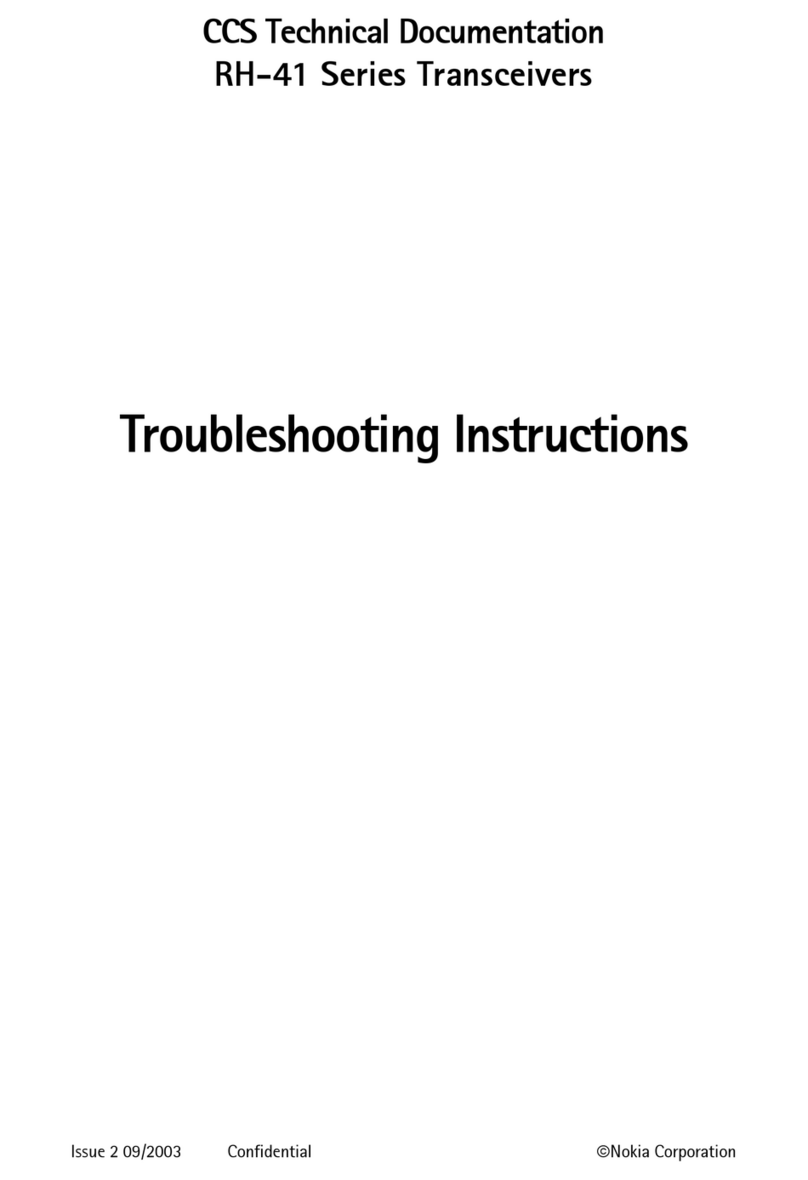
Nokia
Nokia RH-41 Series Troubleshooting instructions
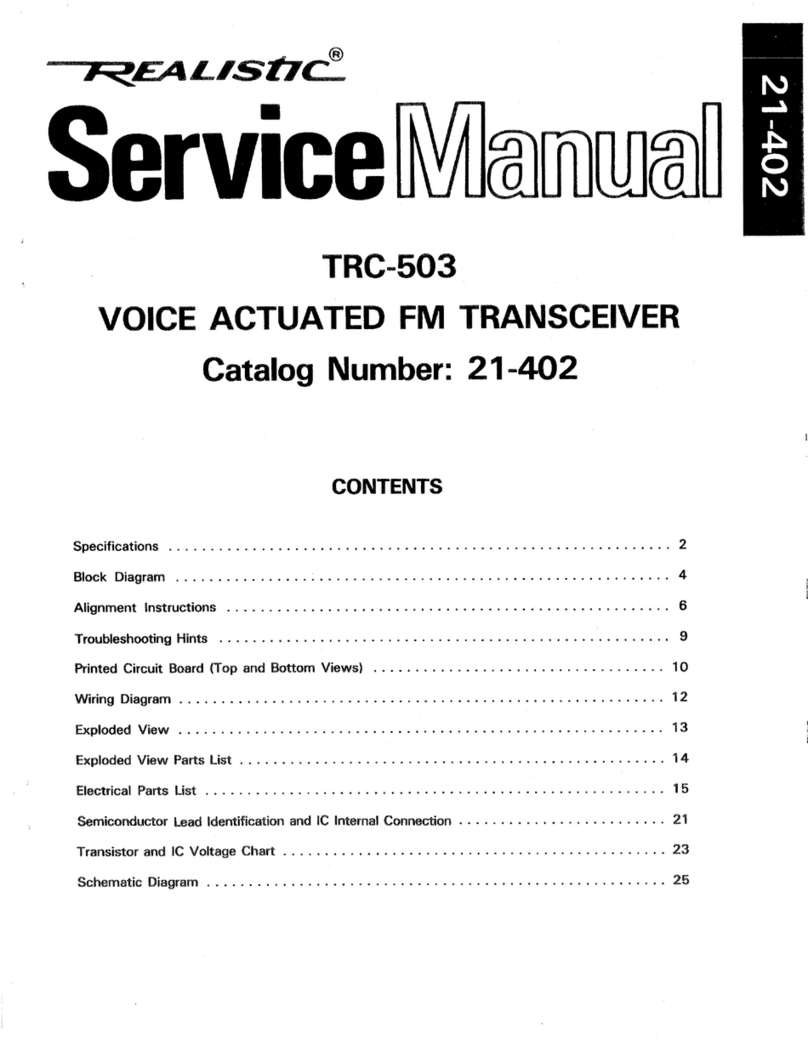
Realistic
Realistic TRC-503 Service manual
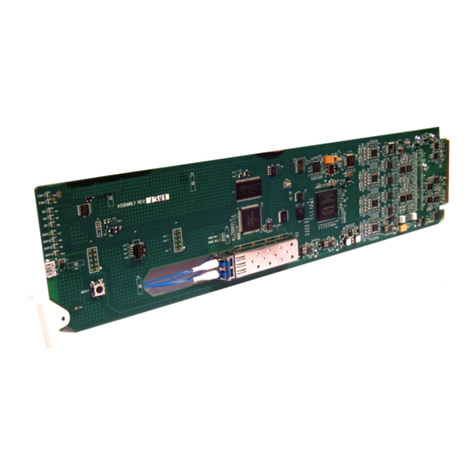
Cobalt Digital Inc
Cobalt Digital Inc 9433-EMDE-75/110 product manual
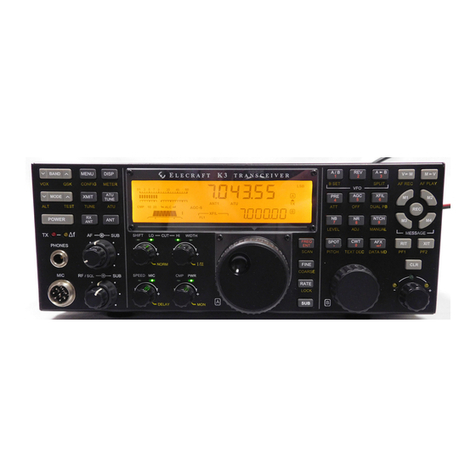
ELECRAFT
ELECRAFT KPA3 installation instructions
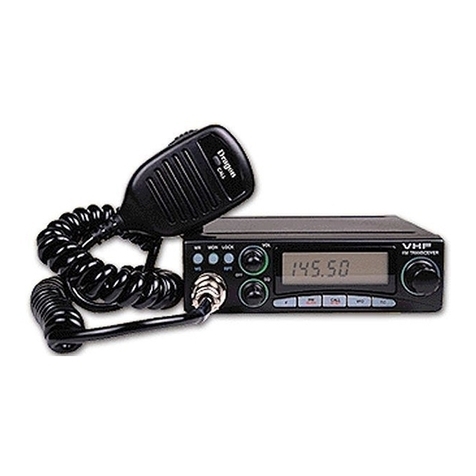
Albrecht
Albrecht AE 550 instruction manual

Vertex Standard
Vertex Standard VX-410 Series operating manual
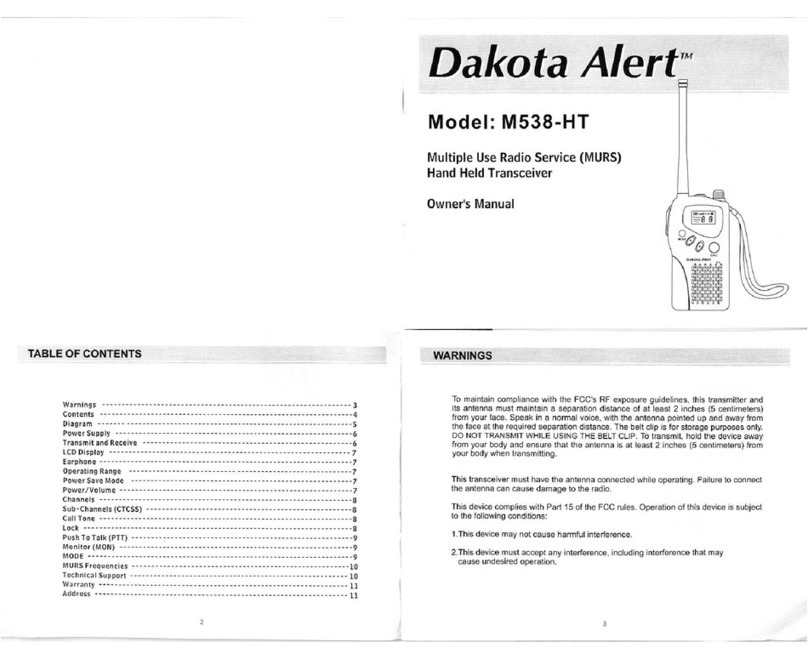
Dakota Alert
Dakota Alert M538-HT owner's manual
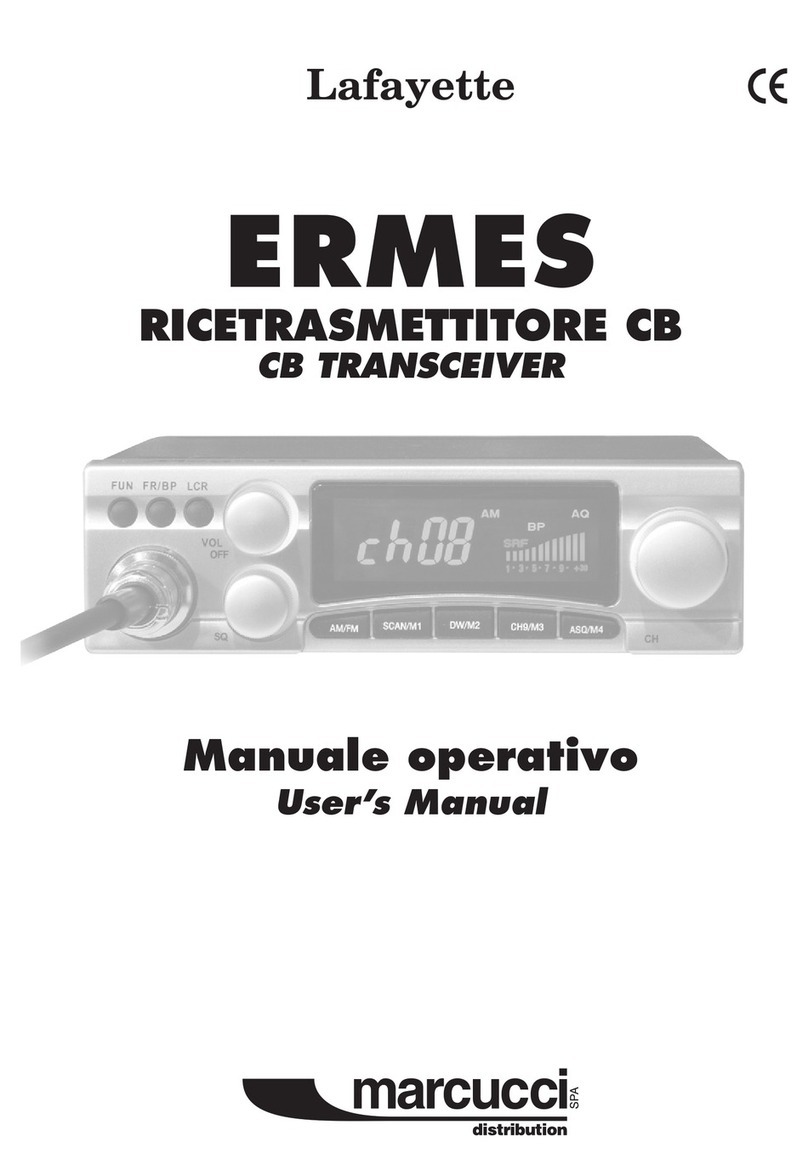
Lafayette
Lafayette ERMES user manual

Kenwood
Kenwood TK 3230 - FreeTalk XLS UHF instruction manual
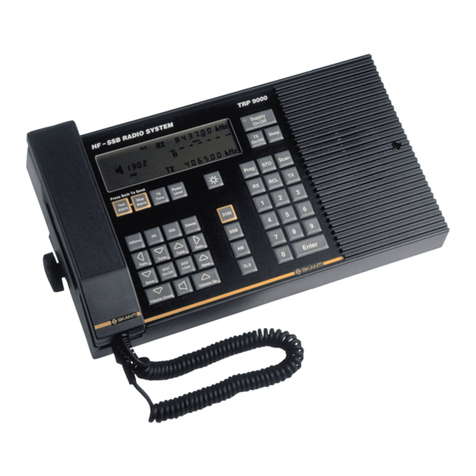
Skanti
Skanti TRP 9500 Technical manual
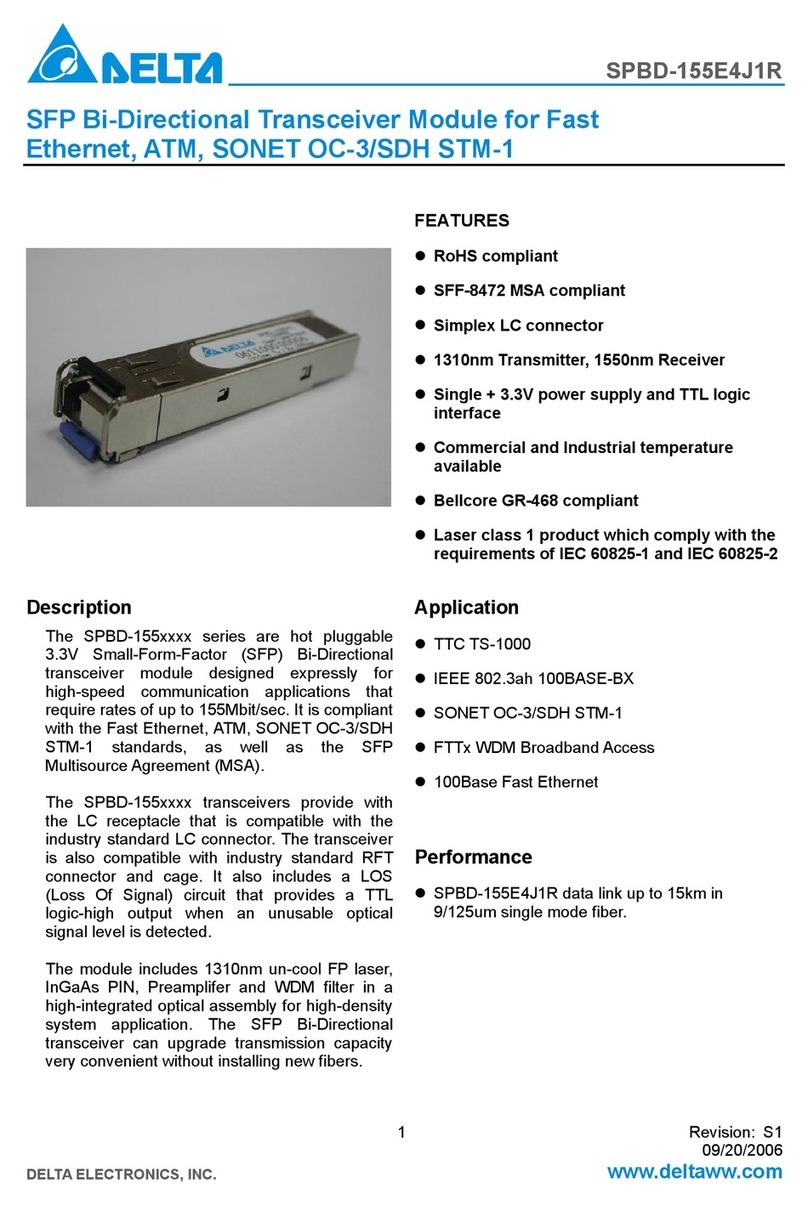
Delta Electronics
Delta Electronics SFP Bi-Directional Transceiver Module... Specification sheet
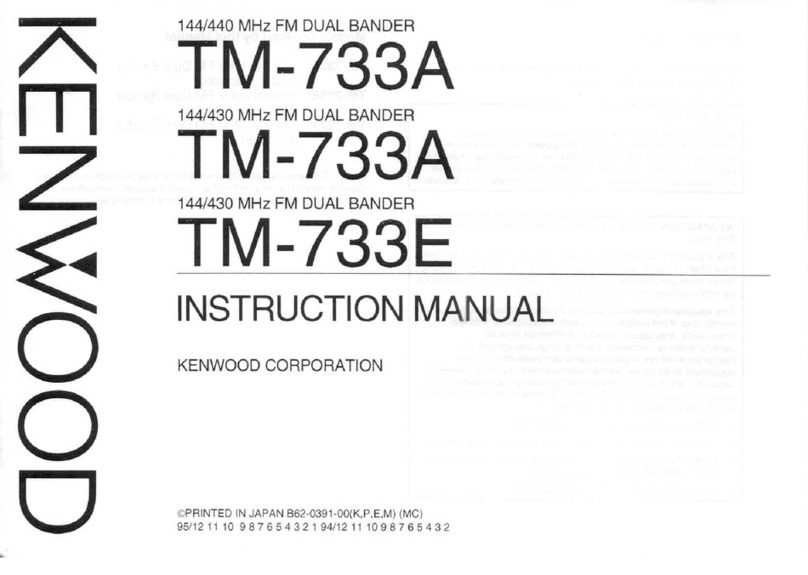
Kenwood
Kenwood TM-733A instruction manual
